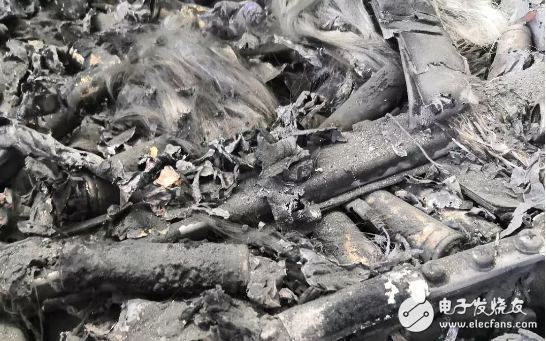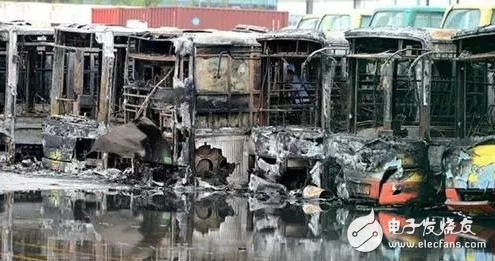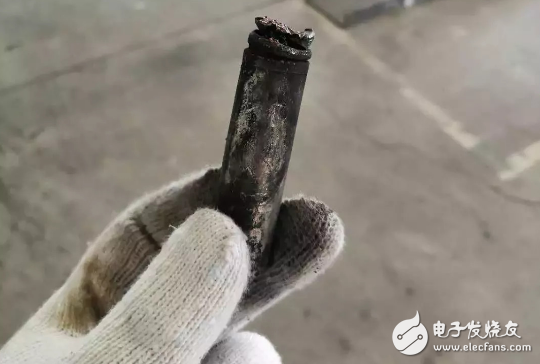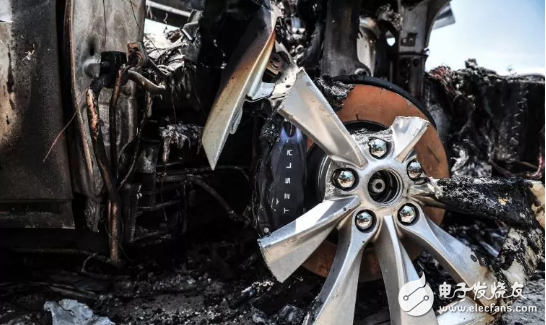The biggest threat to new energy vehicles is not the subsidy decline, but the continuous fire accidents. What is even more worrying is that everyone is already a little numb due to the spontaneous combustion and fire incidents. Is this still an inevitable process in the growth of new things?
Do not. To use new things as an excuse is to perish yourself. Should severely criticize and severely punish the power battery manufacturers and new energy automobile companies involved. This behavior is ruining our common cause.

A battery pack that was disassembled after burning
In 2018, electric vehicles are all a bit "hot". According to incomplete statistics, in the first half of 2018, there were 10 combustion accidents in electric vehicles.
Why do electric cars catch fire? Can't the current technical level of car companies prevent it from catching fire? Or are car companies not investing enough costs in preventing fires?
A few days ago, I dismantled three new energy vehicles that had spontaneous combustion. Comprehensive disassembly analysis, as well as the mechanism and response of battery thermal runaway, the author believes that the frequent spontaneous combustion of electric vehicles is not due to the lack of technical level, but the power battery companies and electric vehicle companies involved, not paying attention to safety, in order to reduce costs , Lax quality control of battery cells, low BMS design requirements, insufficient safety design protection for power battery packs, etc., resulting in fire disaster.
The board is not good for power battery companies and new energy vehicle companies. Competent departments have many barriers in the access link. Now that they have seen so many accidents, have they not taken action?
Analysis of Causes of Fire in Electric Vehicles
When the three electric vehicles I disassembled spontaneously ignited, one was charging; one was in a stopped state; the other was found to be abnormal during driving and caught fire after stopping.
Charging an electric vehicle that caught fire, from the detection data, before the fire, there was a large pressure difference during the battery charging process, but the BMS battery charging did not stop. Until the temperature quickly rises to the 45°C threshold within 10 seconds, charging stops. At this time, the battery static pressure difference has exceeded 500mV, and then the communication was interrupted and spontaneous combustion occurred.
According to the dismantling situation of the second car, there are traces of wading inside. The sealing strip of the battery pack is severely deformed (presumably due to a design problem), and the expected effect of sealing has not been achieved. There are three obvious arc breakdowns at the bottom of the battery pack. The accident site of this vehicle was in Shenzhen. It was raining heavily before, which was consistent with the judgment of the scene. That is, the seal fails, causing spontaneous combustion caused by the vehicle wading and short circuit.

Two electric buses that burn in water in Nanjing
In the third car, the driver noticed an abnormality during the first driving process, pulled over and stopped, and then spontaneously ignited. From the monitoring data, the internal temperature of the battery pack rose from 34°C to 113°C within 20 seconds, and then the communication was interrupted. After on-site dismantling, it was preliminarily judged that individual batteries had deflagrated, which caused the main power line to overheat, damage to the insulation, and overlap with the battery case and the internal fixing bracket, resulting in a short circuit.
In addition, according to a firefighting unit's summary, there are four main scenarios for the combustion of new energy vehicles:
Burning during charging;
Burning caused by the battery during driving or storage;
Burning caused by collision and rollover;
Burning caused by wading.
Among these four scenarios, burning during charging is the most common.
During the charging process of an electric vehicle, the charging pile will communicate with the BMS (Battery Management System) of the electric vehicle to "handshake" to control the charging conditions. In other words, the BMS will judge the state of the battery and give a reasonable charging plan. However, the question is, how does the BMS know the status of the battery? It is achieved through different Sensor feedback signals.
Let's start with the battery core. Each battery cell has a different "physique". It is specifically manifested in professional parameters such as internal resistance, self-discharge rate, attenuation rate, and polarization. Although professional and technical personnel will group the "physique" of the battery to reduce the difference between the cells, the "physique" of the battery, like a person, will change with the use of time. Good quality batteries have relatively small differences in "physique". To achieve this, the consistency of the selection of materials must be good, the level of automation in the production process must be high, the quality standard must be high, and the cost will be high. Conversely, poor-quality batteries have low cost and large individual differences, and there are great safety hazards. For example, during the charging process, individual batteries overheat and catch fire.

Poor batteries have huge hidden dangers
But the battery cells can never be completely consistent. At this time, BMS needs to intervene to be responsible for the battery management strategy. First of all, I personally think that every battery has different characteristics. BMS should develop a management strategy for it separately, rather than a general design.
Before BMS manages the battery, it must first grasp the battery information, which can only be achieved through sensor monitoring. In other words, the more sensors, the higher the accuracy of the sensors, the more comprehensive the feedback data, and the more accurate the judgment of the BMS on the battery. However, correspondingly, the cost is higher.
During the charging process, if the battery core, BMS, and sensor are not properly coordinated, spontaneous combustion may occur.
What if the BMS fails? Imagine a scenario where our smartphone has a very small probability of failure and needs to be restarted. I believe that any electronic device has a certain probability of failure. And if the BMS malfunctions, or even a brief crash, the consequences are much more serious than the malfunction of the mobile phone. What to do when this happens, is there a second battery management solution that can be backed up? I believe that when there is an "emergency device" in the system, the system is bound to be more secure, but it will also increase the cost.
In addition to charging scenarios, the battery will also burn during driving or stopping. During driving, it is the process of discharging the battery. During the working process, the battery has problems, which is easy to understand, but why does it burn when the vehicle is stopped?
A recent study on several cases of stopping new energy vehicles found that new energy vehicles have had a heavy load or driving experience for a long time before stopping. The spontaneous combustion in the process of stopping driving is actually a sequelae, and how is this sequelae caused?
Reason 1: When the car is driving, the battery is in a state of heat dissipation due to the effect of air flow. But when the car stops, the car stalls and the cooling system stops working. At this time, the heat of the battery may not be completely dissipated, and the heat may accumulate locally, leading to high temperature and burning.
The solution is simple. After the car is stopped, the heat dissipation system should continue to work (this requires an active heat dissipation device). I remember a fuel car of mine before. After parking, the front heat dissipation fan (called electronic fan at the time) would still work. Continue to whirl for a while. Early turbocharged engines also had similar requirements, and they could not be stopped immediately after stopping. For new energy vehicles, this is not a difficult technology. But it is indeed necessary to increase some costs, and it may also sacrifice some energy density.
Reason two: influence of ambient temperature. Most of the temperature in the environment comes from the reflection of heat on the ground. So how many degrees can the ground temperature be? According to data from the Tianjin Meteorological Bureau, the highest surface temperature in summer reaches 64.7°C, and the lowest temperature also exceeds 50°C. The suitable working temperature of lithium batteries is mostly not more than 50℃, and lithium battery packs are often installed at the bottom of the car, very close to the ground, and a large amount of heat radiated by the ground is absorbed by the battery pack. If the problem accumulates with the first cause, or if the vehicle is parked for a long time, it may cause the heat of the car battery to run out of control and cause a combustion accident.
The solution is not difficult, that is, to design the battery pack for heat insulation, such as adding a layer of heat insulation pad inside the battery pack, which is also conducive to heat preservation in winter. However, the addition of heat insulation pads will bring three problems: first, the cost increases; second, the natural cooling performance is reduced, and an active heat dissipation system is required; third, the energy density of the battery pack decreases slightly.
Reason three: The low-voltage power supply of the new energy vehicle is still working when it is stopped, such as GPS signal transmission, trip computer, remote control lock and other functions. If the low-voltage power fails, there may also be safety hazards.
In addition to the battery cell, BMS, and Pack design, the other small links cannot be ignored. Such as IP67 waterproof, such as the quality and layout of the wiring harness.
The above explanation of the cause of the accident, the solutions all point to increased costs. But if the cost is high, can accidents be avoided? I also want to talk about the case of Tesla accident. As we all know, Tesla is a "toy" for the wealthy, and cost input should not be a problem. In the first half of 2018, a total of three accidents involving Tesla were found online:
In January, in Chongqing, Tesla burned without charging and without a collision.
In March, in the United States, Tesla burned after hitting the isolation fence.
In May, in the United States, Tesla spontaneously ignited again due to a collision.
It can be seen that Tesla has not achieved 100% safety.

In June 2017, a fire broke out after a Tesla hit the guardrail in Rizhao, Shandong
I think here, security should be redefined.
For new technologies, it is impossible to demand 100% of accidents, but to minimize the consequences of accidents. In the case of new energy vehicles, it is necessary to consider the design, in the event of an accident, 100% guarantee of personal safety. We still look at the example of Tesla. Above the Tesla battery pack, there is a layer of flame-retardant aluminum plate. This layer may not be able to completely block the combustion, but at least it can give the driver and passengers a few minutes of escape time.
Therefore, the so-called safety of new energy vehicles is a 100% guarantee for the safety of the car’s superiors and passengers. Early warning should be given to the driver and passengers and sufficient time to escape should be given.
Safety is always relative. It is simple to increase costs. The key is market recognition and customers are willing to pay. No one would want to buy a tank with a speed of ten kilometers per hour, although it should be safe. But I think in order to reduce the occurrence of accidents, some costs still have to be spent:
First, high-quality batteries. The energy density is getting higher and higher, and there is no doubt that the quality requirements of the battery are getting higher and higher. What are the recipes of each family in the ternary era? Is it a real ternary material, or a mixture of different formulations? How consistent? To improve the quality of batteries and reduce risks from the source, the money should be spent.
Second, the safe Pack design. The so-called Pack design of some manufacturers is actually Pack layout. what differences are there? For example, where should Pack's temperature sensor be placed? Pack layout method is to install the battery module, find a "reasonable" place, and install it. The Pack design method is to combine the heat dissipation system and air duct design in the structure, set the temperature monitoring point in advance, and then further simulate and experiment to finally confirm it.
Third, the margin design. As the name implies, in design, it is necessary to leave a design margin. For example, as mentioned in the previous article, if the BMS fails, is there a backup system that can temporarily guarantee the safety of the system? This backup system may not be able to fully function BMS, but at least it must be safe.
Fourth, the thermal management system. If the thermal management system is the lifeblood of new energy vehicles, it should not be overstated. The energy density of batteries is getting higher and higher, and the requirements for thermal management are getting higher and higher. The increase in energy density will lead to an increase in charging speed. I think at least a water cooling system is necessary.
Fifth, the fault escape system. Regardless of the cause of a fire in a new energy vehicle, it is necessary to allow sufficient time for the drivers and passengers to escape. Especially business cars or SUVs with three rows of seats, and electric buses. Therefore, for failure, early warning; in the system, at least there must be a design to delay the fire, to maximize the escape time.
Sixth, safety training. Simply put, it is to tell new energy vehicle owners what to do if an accident occurs. For example, you must give up your belongings, escape as soon as possible, keep a safe distance from the accident vehicle, stand on the wind, and so on. Improper handling of accidents is also an important cause of personal injury.
Seventh, severely punish the responsible party and support huge claims. Except for human lives, everything else can be counted with money. There is such a story: a car produced by Ford Motor, its design safety hazards, but if the cost of 16 yuan is increased, the safety factor will increase a lot. Ford knew about this situation, but they calculated an account. If the cost of adding a 16 yuan baffle to each car exceeded their compensation for the accident, they chose to compensate. From this perspective, compensation is actually a payment for product cost control, so it is estimated that the major automakers have to settle the accounts carefully where the money is spent.
In 2018, there were many burning accidents of fuel vehicles, but it seems that they will not have such a big focus as new energy vehicles. The recent increase in fire incidents of new energy vehicles is directly related to the increase in energy density requirements of subsidy policies. According to the principle of relative safety, this means that there must be safer safeguards; including increasing the charging speed, but also a more effective temperature control system.
However, it is clear that power battery companies and new energy car companies have not done so. They calculated the input and output just like Ford, which saved 16 yuan on the baffle. In this way, while we call on power battery and new energy vehicle companies to self-examine and make corrections, we must also call on the competent authorities to severely punish those responsible for fire incidents caused by shoddy manufacturing, especially for companies responsible for causing personal injury accidents, cancel their subsidy qualifications and even cancel their subsidy qualifications. Announcement to expel the new energy vehicle market. Otherwise, the prospects and achievements of the entire new energy automobile industry may be ruined.
Multi function remote manual pulse generator for control of all axes.
Manual Sensor,Miniature Optical Kit Encoder,Rotary Encoder With Led Ring,Optical Quadrature Encoder
Yuheng Optics Co., Ltd.(Changchun) , https://www.yuhengcoder.com
